top of page
Kady Lyons

Round Stingray

Sampling Buddies
In the field with Ralph Appy and Kady Lyons

Two Harbors, Catalina Island

Round Stingray
1/8
Physiological Effects of Contaminants
Physiological Effects of Contaminants
Goals
Determine physiological impacts of contaminant exposure in stingrays
Areas of Interest
Organochlorine contaminants, growth, reproduction, stress response
Summary
Round Stingrays (Urobatis halleri) are being used as a model species to explore how contaminant exposure influences their ability to reproduce, respond to stress, grow and osmoregulate. In particular, I am interested in physiological effects in embryos as early life is often the most sensitive period.
Groups Involved
University of Calgary, CSULB
bottom of page